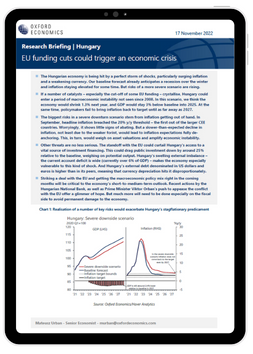Research Briefing
| Nov 17, 2022
EU funding cuts could trigger an economic crisis in Hungary

The Hungarian economy is being hit by a perfect storm of shocks, particularly surging inflation and a weakening currency. Our baseline forecast already anticipates a recession over the winter and inflation staying elevated for some time. But risks of a more severe scenario are rising.
What you will learn:
- If a number of catalysts – especially the cut-off of some EU funding – crystallise, Hungary could enter a period of macroeconomic instability not seen since 2008. In this scenario, we think the economy would shrink 1.3% next year, and GDP would stay 3% below baseline into 2025. At the same time, policymakers fail to bring inflation back to target until as far away as 2027.
- The biggest risks in a severe downturn scenario stem from inflation getting out of hand. In September, headline inflation breached the 20% y/y threshold – the first out of the larger CEE countries. Worryingly, it shows little signs of abating. But a slower-than-expected decline in inflation, not least due to the weaker forint, would lead to inflation expectations fully de-anchoring. This, in turn, would weigh on asset valuations and amplify economic instability.
- Other threats are no less serious. The standoff with the EU could curtail Hungary’s access to a vital source of investment financing. This could drag public investment down by around 25% relative to the baseline, weighing on potential output. Hungary’s swelling external imbalance – the current account deficit is wide (currently over 6% of GDP) – makes the economy especially vulnerable to this kind of shock.
Tags:
Related Services

Service
European Cities and Regions Service
Regularly updated data and forecasts for 2,000 locations across Europe.
Find Out More
Service
European Macro Service
A complete service to help executives track, analyse and react to macro events and future trends for the European region.
Find Out More
[autopilot_shortcode]
